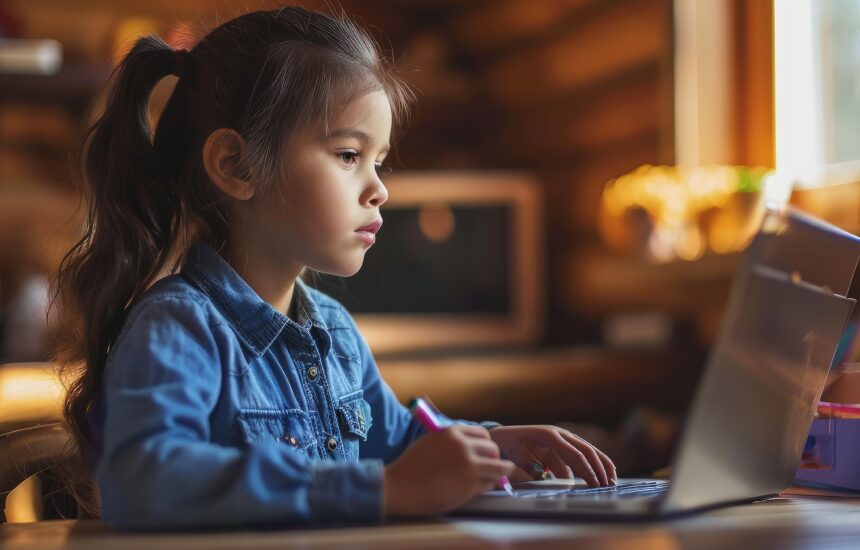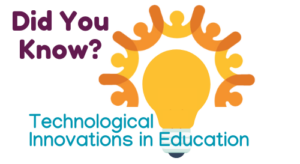E-Schools: Navigating Early Education in the Digital Age


 The children of today are entering a world profoundly intertwined with advanced technology, where tablets and computers are as ubiquitous as toys. It is important for educators to learn about these technologies and their potential impact — both positive and negative — on young children.
The children of today are entering a world profoundly intertwined with advanced technology, where tablets and computers are as ubiquitous as toys. It is important for educators to learn about these technologies and their potential impact — both positive and negative — on young children.
E-schools, a product of the digital revolution, are redefining the educational landscape, promising young learners unprecedented access to knowledge and learning experiences. They stand at the intersection of technology and education, promising a flexible and personalized platform where children can learn at their own pace, acquire practical skills, and connect with peers.
Displacement, pandemics, wars, and teacher shortages all have led some to consider e-schools for young children. A variety of supplemental or full-time programs are available to transition children from passive consumption of technology to more active use:
Passive Consumption
Definition: Using technology in a way that doesn’t require active mental or physical engagement.
Examples: Watching videos, listening to music or stories without interaction, scrolling through photos.
Active Consumption
Definition: Engaging with technology in a way that requires thought, decision-making, or creation.
Examples: Coding programs, playing interactive educational games, creating digital art or music.
In this article, we will explore e-schools and their place in the early education landscape, delving into the opportunities they present, the challenges they pose, and the potential they hold.
 Personalized learning stands as a central pillar of e-schools. Children interact with various types of content—including lessons, assignments, texts, games, and quizzes—while maintaining some kind of communication with their teachers and peers.
Personalized learning stands as a central pillar of e-schools. Children interact with various types of content—including lessons, assignments, texts, games, and quizzes—while maintaining some kind of communication with their teachers and peers.
This approach eschews a one-size-fits-all model, instead providing a journey of tasks tailored to each child’s individual needs and pace of mastery. However, questions remain regarding the level of true engagement and, more importantly, the impact on children’s learning and development.
Most e-schools strive to foster an interactive learning environment, employing digital tools and resources to augment the learning experience and position education as an active process encompassing exploration, creation, and collaboration.
Importantly, e-schools are not necessarily the same as remote learning; they can be incorporated into conventional classroom settings, thereby supplementing existing teaching with an additional layer of learning. For example, Slooh’s online telescope offers a supplemental curriculum that allows children to learn about space exploration, knowledge typically not part of teacher education programs.
Just as we ensure the safety of a classroom environment by meticulously checking for hazards, conducting background checks of caretakers, and limiting group sizes, we also must analyze the pros and cons and assess the outcomes of e-schools to determine their effectiveness and impact. As we navigate through this evolving educational landscape, an evidence-based and analytical approach will be paramount in understanding the true potential and limitations of e-schools in early childhood education.
Online early childhood programs are experiencing rapid growth. We cannot ignore the cost-effectiveness of online preschool programs, particularly for school districts with limited funding. Additionally, for children in rural communities with reliable internet access, online preschool might serve as a better alternative than having no preschool at all. Some online early childhood programs have demonstrated notable measures of academic achievement (albeit through self-reported research).
At the same time, concerns remain regarding the long-term benefits of online early childhood education. Questions persist about the sustainability of its benefits and the potential missed opportunities for children to develop crucial cognitive, language, social, and emotional skills.
In March 2020, the National Association for the Education of Young Children (NAEYC) published a critical analysis of online learning for early years, highlighting the following areas of concern:
Technology and functionality of e-schools has advanced considerably since 2020 and continues to develop rapidly. Online learning seems to offer positive opportunities to fill gaps and provide new learning material; nevertheless, it should be approached cautiously to ensure that young children’s needs are met and wellbeing protected.
Supplemental Educational Apps. A review by VeryWellFamily shed light on educational applications designed to serve as supplemental learning tools for children under 8 years old. These apps, including Khan Academy Kids, Moose Math, Busy Shapes, Daniel Tiger’s Day and Night, and Homer Learn and Grow, aim to complement traditional learning methods rather than replace them. They were found to provide engaging and interactive content that reinforces concepts taught in a traditional classroom, offering an additional layer of support and enrichment to a child’s educational journey.
Full Online Early Childhood Programs. In contrast, full online preschool programs, such as Masterminds Early Learning, purport to serve as a primary source of preschool education. These programs ask parents to prepare by creating a conducive learning environment at home by dedicating comfortable spaces to learning, ensuring regular breaks to avoid prolonged screen time, and facilitating video chats with other children. Patience and encouragement can facilitate transition to this format.
As we know, some young children are already using technology informally to play games such as Roblox.
These games are often popular among young children because they are interactive, offer a variety of adventure, and include some social interaction features.
We should pay close attention to concerns regarding young children’s use of games that may not be age appropriate, as well as the risks of potential inappropriate online interactions and excess screen time.
Meanwhile, we can learn from these uses that children enjoy online interactions that involve reward systems, achievements, and cooperative play elements. They may lead to incidental learning such as basic computer navigation skills, critical thinking, puzzle-solving, artistic expression, and the value of teamwork. Such concepts could also be incorporated into educational platforms to combine the fun of online gaming with planned and more monitored learning opportuntiies.
The following list from the Common Sense Privacy Program may be helpful in critically examining and assessing the potential safety of educational programs for our youngest learners.
✓ Does the product ensure safe interactions among children and trusted users?
✓ Can children’s personal information be publicly displayed, and how is it protected?
✓ Are social interactions between users monitored or moderated, and is artificial intelligence used for this?
✓ What type of data is collected about the child, and does it extend beyond product requirements to include geolocation, biometric, health, or behavioral data?
✓ Is there a clear opt-in consent mechanism for collecting data, and what are the policies regarding parental consent?
✓ Is information shared with third parties, and can third parties log into the child’s account?
✓ Is data shared for analytics purposes, and how does this enhance or personalize the learning experience?
✓ Is the collected data stored in an encrypted format, and what measures are in place to protect sensitive information?
✓ Are there protocols in place to notify users in the event of a data breach, and how transparent is the platform about such incidents?
✓ What rights do parents have over the data that their child uploads, and can they access, modify, or delete this information?
✓ Can children create or upload content, and who has access to this content?
✓ Is there a clear data retention policy in place, and how long is user data stored?
✓ What happens to a child’s created content when an account is cancelled or terminated?
✓ Is the child’s data sold, and can parents opt out of having their child’s data sold?
✓ What values are embedded in the content, and does it align with educational and ethical standards?
✓ If AI is used to analyze data and recommend content, what ethical considerations are taken into account, and what kind of data is the AI trained on?
As e-schools rapidly evolve, artificial Intelligence (AI) is set to play a pivotal role in creating personalized learning journeys.
Imagine if content could adapt in real time through a completely autonomous set of complex pathways that continually readjust to keep the child engaged and slightly challenged most of the time. Sophisticated AI algorithms would analyze a child’s profile; sift through a plethora of content; and discern themes, difficulty levels, and learning styles. Recommendations would adapt as the child grows and their needs evolve, ensuring a truly dynamic learning experience. Such an adaptive approach mirrors the scaffolding provided by skilled teachers.
Looking ahead, we might also witness the integration of virtual reality (VR) and augmented reality (AR) in e-schools, particularly with the advent of the metaverse (watch Lex Fridman’s interview with Mark Zuckerberg). This could revolutionize the way children learn, offering immersive experiences that were once considered science fiction.
Yet, the future might be about more than technology. E-schools have the potential to significantly improve accessibility, reaching children in rural areas, breaking down barriers, and offering quality education regardless of various traditional constraints. Multilingual support and offline access could further level the playing field, ensuring every child has the opportunity to learn.
For some communities, particularly those with limited access to traditional educational resources, e-schools might offer a valuable alternative. Yet despite the promise of e-schools, we must acknowledge the irreplaceable value of in-person interactions for a child’s development. The intricacies of brain development, bolstered by the “serve and return” of adult-child interactions, remain a challenge for technology to replicate.
Childhood Education International (CE International) is dedicated to empowering leaders to catalyze innovation and cultivate positive transformations in their educational ecosystems, always emphasizing the responsible adoption of emerging technologies.
Note: CE International does not endorse any of the products or online learning materials mentioned in this article.